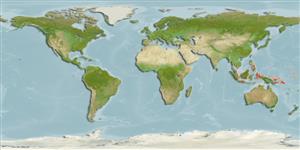Élasmobranches (requins et raies) (sharks and rays) >
Orectolobiformes (Carpet sharks) >
Hemiscylliidae (Bamboo sharks)
Etymology: Hemiscyllium: hemi-, from hemisys (Gr.), half, presumably referring to similarity and/ or close affinity to Scyllium (=Scyliorhinus, now in Scyliorhinidae) and/or Chiloscyllium; skylion, Greek for dogfish or small shark. (See ETYFish); galei: In honor of underwater photographer and shark enthusiast Jeffrey Gale, who successfully bid to help conserve this species at a charity auction, and who financially supported Conservation International’s efforts to preserve its habitat. (See ETYFish).
Environment: milieu / climate zone / depth range / distribution range
Écologie
marin récifal; profondeur 2 - 25 m (Ref. 114942). Tropical
Western Pacific: apparently confined to Cenderawasih Bay, Papua Barat Province, Indonesia.
Taille / Poids / Âge
Maturity: Lm ? range ? - ? cm
Max length : 56.8 cm TL mâle / non sexé; (Ref. 74956)
Description synthétique
Morphologie | Morphométrie
This species of bamboo shark is distinguished by its unique combination of white lines/spots along the margin of the large, dark saddles on the back, scattered white spots particularly on the upper side, and a row of 7-8 well-defined, horizontally-ovate, dark spots on the lower side between the abdomen and caudal-fin base (Ref. 74956).
Occurs on shoreline fringing reefs or shallow patch reefs; observed at night at depths of 2-25 m (extreme depth from Ref. 114942), usually seen resting on the bottom, occasionally observed while slowly swimming or 'walking' over the bottom with the pectoral and pelvic fins. Probably sedentary during daylight hours, sheltering under rocky outcrops or tabular corals, typical for other family members (Ref. 74956).
Life cycle and mating behavior
Maturité | Reproduction | Frai | Œufs | Fécondité | Larves
Allen, G.R. and M.V. Erdmann, 2008. Two new species of bamboo sharks (Orectolobiformes: hemiscylliidae) from Western New Guinea. aqua, Int. J. Ichthyol. 13(3-4):93-108. (Ref. 74956)
Statut dans la liste rouge de l'IUCN (Ref. 130435)
Menace pour l'homme
Harmless
Utilisations par l'homme
Plus d'informations
PaysZones FAOÉcosystèmesOccurrencesIntroductionsStocksÉcologieRégime alimentaireÉléments du régime alimentaireConsommation alimentaireRation
Noms communsSynonymesMétabolismePrédateursÉcotoxicologieReproductionMaturitéFraiRassemblement de ponteFéconditéŒufsDéveloppement de l'œuf
Taille/ÂgeCroissanceLongueur-poidsLongueur-longueurFréquences de longueursMorphométrieMorphologieLarvesDynamique des populations larvairesRecrutementAbondanceBRUVS
RéférencesAquacultureProfil d'aquacultureSouchesGénétiqueElectrophoresesHéritabilitéPathologiesTraitementNutrientsMass conversion
CollaborateursImagesStamps, Coins Misc.SonsCiguateraVitesseType de nageSurface branchialeOtolithesCerveauxVision
Outils
Articles particuliers
Télécharger en XML
Sources Internet
Estimates based on models
Preferred temperature (Ref.
123201): 28.1 - 29.2, mean 28.8 °C (based on 448 cells).
Phylogenetic diversity index (Ref.
82804): PD
50 = 0.5020 [Uniqueness, from 0.5 = low to 2.0 = high].
Bayesian length-weight: a=0.00407 (0.00181 - 0.00918), b=3.09 (2.89 - 3.29), in cm total length, based on LWR estimates for this (Sub)family-body shape (Ref.
93245).
Niveau trophique (Ref.
69278): 3.4 ±0.3 se; based on size and trophs of closest relatives
Fishing Vulnerability (Ref.
59153): Moderate vulnerability (43 of 100).
